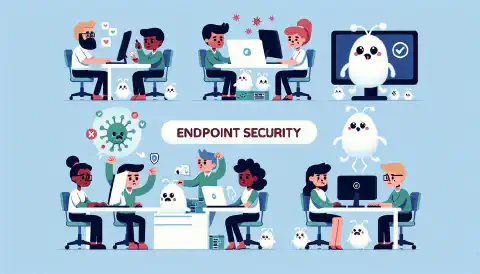Defending Your Mobile Fortress: Navigating the Rise of Mobile Malware Safely

Table of Contents
The Rise of Mobile Malware: Staying Safe on the Go
With the increasing popularity of smartphones and mobile devices, the threat of mobile malware has also been on the rise. Mobile malware refers to malicious software specifically designed to target mobile devices and exploit their vulnerabilities. In this article, we will explore the evolution of mobile malware, common types of mobile malware, methods of distribution, impacts of mobile malware, and most importantly, how to protect yourself from these threats.
Key Takeaways
- Mobile malware is evolving and becoming more sophisticated, with new types and methods of distribution constantly emerging.
- Common types of mobile malware include trojan horses, ransomware, spyware, adware, and phishing attacks.
- Mobile malware can be distributed through malicious apps, drive-by downloads, SMS phishing, infected websites, and Bluetooth exploits.
- The impacts of mobile malware can range from data theft and privacy breaches to financial losses, identity theft, disruption of services, and damage to reputation.
- To protect yourself from mobile malware, install a reliable antivirus app, keep your operating system and apps updated, download apps from trusted sources, exercise caution with public Wi-Fi, and enable two-factor authentication.
The Evolution of Mobile Malware
Early Mobile Malware
Early mobile malware marked the beginning of a new era in cybersecurity. As smartphones became more prevalent, cybercriminals saw an opportunity to exploit these devices for their malicious activities. Unique malware attacks started to emerge , targeting the vulnerabilities of mobile operating systems and apps.
Sophisticated Malware Attacks
Sophisticated malware attacks are becoming increasingly common in the mobile landscape. These attacks are designed to bypass traditional security measures and exploit vulnerabilities in mobile devices. Cybercriminals are constantly evolving their techniques to stay one step ahead of security experts. To protect yourself from sophisticated malware attacks, it is important to understand the tactics used by attackers and take appropriate precautions.
Key Characteristics of Sophisticated Malware Attacks:
- Advanced obfuscation techniques: Sophisticated malware often uses advanced obfuscation techniques to hide its malicious code. This makes it difficult for antivirus software to detect and remove the malware.
- Zero-day exploits: Sophisticated malware may exploit previously unknown vulnerabilities in mobile operating systems or applications. These vulnerabilities, known as zero-day exploits, can be highly effective in compromising devices.
- Social engineering tactics: Cybercriminals often use social engineering tactics to trick users into downloading or installing malware. This can include phishing emails, fake app stores, or deceptive advertisements.
Protecting Against Sophisticated Malware Attacks:
- Keep your operating system and apps updated: Regularly updating your mobile device’s operating system and applications is crucial for protecting against sophisticated malware attacks. Updates often include security patches that address known vulnerabilities.
- Be cautious of app permissions: When installing new apps, carefully review the permissions they request. Avoid granting unnecessary permissions that could potentially be exploited by malware.
- Use a reliable antivirus app: Install a reputable antivirus app on your mobile device and keep it updated. Antivirus software can help detect and remove sophisticated malware.
- Exercise caution with app downloads: Only download apps from trusted sources, such as official app stores. Be wary of third-party app stores or websites offering free versions of paid apps, as these can be a source of malware.
- Enable two-factor authentication: Two-factor authentication adds an extra layer of security to your mobile device. By requiring a second form of verification, such as a code sent to your phone, it can help prevent unauthorized access to your device and accounts.
Tip: Stay informed about the latest mobile malware threats and security best practices. Following reputable cybersecurity blogs and news sources can help you stay ahead of emerging threats and protect your mobile devices effectively.
Emerging Trends in Mobile Malware
As mobile technology continues to advance, so does the sophistication of mobile malware. Cybercriminals are constantly finding new ways to exploit vulnerabilities in mobile devices and applications. It is crucial for users to stay informed about the emerging trends in mobile malware to protect themselves from potential threats.
Common Types of Mobile Malware

Trojan Horses
Trojan Horses are one of the most common types of mobile malware. They are malicious programs that disguise themselves as legitimate apps or software. Once installed, they can perform various harmful actions without the user’s knowledge or consent.
Ransomware
Ransomware is a type of mobile malware that has become increasingly prevalent in recent years . It is a malicious software that encrypts a user’s files or locks their device, demanding a ransom payment in exchange for restoring access. Ransomware attacks can have devastating consequences for individuals and organizations, causing financial losses, data breaches, and disruption of services.
Spyware
Spyware is a type of mobile malware that is designed to secretly monitor and collect information from a device without the user’s knowledge or consent. It can be installed through malicious apps, infected websites, or even through Bluetooth exploits. Once installed, spyware can track a user’s online activities, record keystrokes, capture screenshots, and access personal information such as passwords and credit card details.
Adware
Adware is a type of mobile malware that is primarily designed to display unwanted advertisements on a user’s device. It often comes bundled with legitimate apps or is disguised as a useful utility, making it difficult for users to identify and remove. While adware may seem less harmful compared to other types of malware, it can still pose significant risks to users’ privacy and security.
- Adware can collect personal information such as browsing habits, location data, and even login credentials, which can be used for targeted advertising or sold to third parties.
- It can consume a significant amount of device resources, leading to decreased performance and battery life.
- Adware can also redirect users to malicious websites or download additional malware onto their devices.
To protect yourself from adware:
- Be cautious when downloading apps from third-party sources and only download from trusted app stores.
- Read app reviews and check the permissions requested by the app before installation.
- Regularly update your operating system and apps to ensure you have the latest security patches.
- Install a reputable antivirus app that can detect and remove adware.
- Avoid clicking on suspicious ads or pop-ups, as they may lead to adware infections.
Tip: If you encounter persistent adware on your device, consider performing a factory reset to remove any malicious software.
Phishing Attacks
Phishing attacks are a common type of mobile malware that aim to deceive users into revealing sensitive information such as passwords, credit card numbers, or social security numbers. These attacks often occur through fraudulent emails, text messages, or websites that mimic legitimate organizations or services. It is important to be aware of the following key points when it comes to phishing attacks:
- Be cautious of unsolicited communications: Avoid clicking on links or downloading attachments from unknown sources, especially if they request personal information.
- Verify the sender’s identity: Double-check the email address or phone number of the sender to ensure it is legitimate.
- Pay attention to URL inconsistencies: Check the URL of websites to ensure they match the official domain of the organization.
- Enable two-factor authentication: Implementing two-factor authentication adds an extra layer of security by requiring a second form of verification, such as a unique code sent to your mobile device.
Tip: If you suspect an email or message to be a phishing attempt, it is best to contact the organization directly through their official channels to verify its authenticity.
Methods of Mobile Malware Distribution

Malicious Apps
Malicious apps pose a significant threat to mobile device security. These apps are designed with the intention of compromising the user’s device and stealing sensitive information. It is crucial for users to be cautious when downloading and installing apps from untrusted sources. By following best practices and implementing security measures, users can protect their devices and secure critical assets.
Drive-by Downloads
Drive-by downloads are a common method used by cybercriminals to distribute mobile malware without the user’s knowledge or consent. These attacks occur when a user visits a compromised website or clicks on a malicious link, triggering the automatic download and installation of malware onto their device. It is important to be aware of the risks associated with drive-by downloads and take necessary precautions to protect yourself.
- Drive-by downloads exploit vulnerabilities in web browsers and plugins, allowing malware to be silently installed on a user’s device.
- Cybercriminals often use social engineering techniques to trick users into visiting compromised websites or clicking on malicious links.
- To protect yourself from drive-by downloads, ensure that your web browser and plugins are up to date with the latest security patches.
- Be cautious when clicking on links, especially from unfamiliar or suspicious sources.
- Consider using a reputable ad-blocker or script-blocking extension to prevent drive-by downloads from malicious advertisements or scripts on websites.
- Regularly scan your device with a reliable antivirus app to detect and remove any potential malware infections.
Tip: Enable automatic updates for your web browser and plugins to ensure you have the latest security patches and protection against drive-by downloads.
SMS Phishing
SMS phishing, also known as smishing, is a method used by cybercriminals to deceive and manipulate users through text messages. These messages often appear to be from a trusted source, such as a bank or a popular service provider, and contain a sense of urgency to prompt immediate action. Phishing attacks via SMS can lead to serious consequences, including identity theft and financial losses.
- Users should be cautious of any unsolicited text messages asking for personal information or requesting immediate action.
- It is important to never click on links or download attachments from unknown or suspicious text messages.
- If you receive a suspicious text message, do not reply or provide any personal information.
- Report the message to your mobile service provider or the appropriate authorities to help prevent further attacks.
Tip: Regularly review your mobile service provider’s security guidelines and recommendations to stay informed about the latest SMS phishing techniques and how to protect yourself.
Infected Websites
Infected websites are a common method used by cybercriminals to distribute mobile malware. These websites are designed to exploit vulnerabilities in web browsers and operating systems, allowing malware to be downloaded onto a user’s device without their knowledge or consent.
- Cybercriminals often use techniques such as drive-by downloads, where malware is automatically downloaded when a user visits an infected website.
- Infected websites can also trick users into downloading malicious files or clicking on malicious links, leading to the installation of malware.
- It is important to note that even legitimate websites can become infected if they have not implemented proper security measures.
To protect yourself from mobile malware distributed through infected websites:
- Keep your web browser and operating system up to date with the latest security patches and updates.
- Be cautious when visiting unfamiliar websites or clicking on suspicious links.
- Use a reliable antivirus app that can detect and block malicious websites.
- Regularly scan your device for malware and remove any detected threats.
Tip: Avoid downloading files or clicking on links from websites that you do not trust or that have a suspicious reputation.
Bluetooth Exploits
Bluetooth exploits are a growing concern in the realm of mobile malware. These exploits take advantage of vulnerabilities in the Bluetooth protocol to gain unauthorized access to mobile devices. Attackers can use Bluetooth exploits to steal sensitive data, install malicious software, or even take control of a device.
To protect yourself from Bluetooth exploits, it is important to follow these best practices:
- Disable Bluetooth when not in use to prevent unauthorized connections.
- Keep your device’s firmware up to date to ensure any known vulnerabilities are patched.
- Avoid pairing with unknown devices as they may be compromised.
- Use strong, unique passphrases when pairing with trusted devices to prevent unauthorized access.
By following these precautions, you can significantly reduce the risk of falling victim to Bluetooth exploits and protect your mobile device and personal data.
Impacts of Mobile Malware

Data Theft and Privacy Breaches
Data theft and privacy breaches are some of the most serious consequences of mobile malware infections. When a mobile device is compromised, sensitive information such as personal data, login credentials, and financial details can be stolen by malicious actors. This can lead to severe financial losses, identity theft, and damage to one’s reputation. To protect yourself from data theft and privacy breaches, it is crucial to take the following measures:
- Regularly update your operating system and apps to ensure you have the latest security patches and bug fixes. Outdated software can have vulnerabilities that can be exploited by malware.
- Be cautious when downloading apps and only download from trusted sources such as official app stores. Malicious apps can disguise themselves as legitimate ones and can infect your device with malware.
- Avoid clicking on suspicious links in emails, text messages, or social media. These links may lead to phishing websites designed to steal your personal information.
- Enable strong passwords and consider using a password manager to securely store and manage your login credentials.
- Regularly back up your data to an external storage device or cloud service. In the event of a malware infection, you can restore your data without paying ransom or losing important information.
By following these precautions, you can significantly reduce the risk of data theft and privacy breaches caused by mobile malware.
Financial Losses
Financial losses are one of the significant impacts of mobile malware. Cybercriminals use various tactics to exploit mobile devices and steal sensitive financial information. Here are some key points to consider:
- Phishing attacks: Attackers often use phishing techniques to trick users into revealing their financial credentials, such as login credentials or credit card information. It is essential to be cautious when clicking on links or providing personal information.
- Ransomware: Ransomware is a type of malware that encrypts files on a device and demands a ransom payment in exchange for the decryption key. Victims who fall prey to ransomware attacks may face significant financial losses if they choose to pay the ransom.
- Unauthorized transactions: Mobile malware can gain access to banking apps or payment systems, allowing attackers to make unauthorized transactions using the victim’s financial accounts.
To protect yourself from financial losses caused by mobile malware, it is crucial to follow these best practices:
- Install a reliable antivirus app on your mobile device to detect and remove malware.
- Regularly update your operating system and apps to patch any security vulnerabilities.
- Only download apps from trusted sources, such as official app stores.
- Exercise caution when connecting to public Wi-Fi networks, as they can be vulnerable to man-in-the-middle attacks.
- Enable two-factor authentication for your financial accounts to add an extra layer of security.
Remember, staying vigilant and taking proactive measures can help mitigate the risk of financial losses due to mobile malware.
Identity Theft
Identity theft is a serious concern in the realm of mobile malware. Cybercriminals are constantly developing new techniques to steal personal information and exploit it for financial gain. It is crucial for users to be aware of the risks and take necessary precautions to protect their identities.
Disruption of Services
Mobile malware can have severe consequences, including the disruption of services on your device. When your device is infected with malware, it can slow down or crash your apps, making it difficult to use your device effectively. Malware can also disable important functions on your device, such as the ability to make calls or access the internet.
To mitigate the risk of service disruption caused by mobile malware, it is important to take the following steps:
- Regularly update your operating system and apps to ensure you have the latest security patches and bug fixes. Outdated software can be vulnerable to malware attacks.
- Avoid downloading apps from untrusted sources. Stick to official app stores like Google Play Store or Apple App Store, as they have strict security measures in place to detect and remove malicious apps.
- Be cautious when clicking on links or downloading files from unknown sources, as they may contain malware.
By following these best practices, you can minimize the risk of service disruption caused by mobile malware and ensure a smooth and secure mobile experience.
Damage to Reputation
Mobile malware can have severe consequences for individuals and organizations, including damage to reputation. When a mobile device becomes infected with malware, it can lead to unauthorized access to personal or sensitive information, which can then be used to tarnish an individual’s or organization’s reputation. Here are some key points to consider:
Negative Public Perception: If an individual or organization is known to have been affected by mobile malware, it can create a negative perception among the public. This can result in a loss of trust and credibility.
Loss of Business Opportunities: A damaged reputation can lead to a loss of business opportunities. Potential clients or partners may be hesitant to engage with an individual or organization that has a history of mobile malware incidents.
Legal and Regulatory Consequences: In some cases, the impact of mobile malware on reputation can extend to legal and regulatory consequences. Data breaches resulting from malware attacks can lead to lawsuits and fines.
To protect your reputation from the damaging effects of mobile malware, it is crucial to take proactive measures to prevent infections and mitigate risks. This includes regularly updating your mobile device’s operating system and apps, downloading apps only from trusted sources, and exercising caution when connecting to public Wi-Fi networks. Additionally, implementing strong security measures such as two-factor authentication can add an extra layer of protection against unauthorized access.
Protecting Yourself from Mobile Malware

Install a Reliable Antivirus App
As a cybersecurity expert, it is crucial to emphasize the importance of installing a reliable antivirus app on your mobile device. With the rise of mobile malware , it has become essential to have a robust defense mechanism in place to protect your personal and sensitive information. An antivirus app acts as a shield against various types of malware, including Trojan horses, ransomware, spyware, adware, and phishing attacks. By regularly scanning your device for potential threats, an antivirus app can detect and remove malicious software, ensuring the security of your device and data.
Keep Your Operating System and Apps Updated
Keeping your operating system and apps updated is crucial in ensuring the security of your mobile device. By regularly updating your software, you can stay one step ahead of cybercriminals who constantly seek vulnerabilities to exploit. Superior protection against malware and viruses can be achieved by installing the latest security patches and bug fixes provided by the operating system and app developers.
Download Apps from Trusted Sources
When it comes to downloading apps on your mobile device, it is crucial to exercise caution and only download from trusted sources. Malicious apps can pose a significant threat to your device’s security and your personal information. Here are some important points to keep in mind:
- Stick to official app stores such as the Apple App Store or Google Play Store, as they have strict security measures in place to prevent the distribution of malicious apps.
- Avoid downloading apps from third-party websites or unofficial app stores, as these sources may not have the same level of security and vetting processes.
- Before downloading an app, take the time to read reviews and check the app’s ratings. This can give you insights into the app’s reputation and whether it has been flagged for any suspicious activities.
By following these precautions, you can significantly reduce the risk of downloading and installing malicious apps on your mobile device.
Exercise Caution with Public Wi-Fi
Public Wi-Fi networks are convenient for staying connected while on the go, but they also pose significant security risks. Hackers can easily intercept the data transmitted over these networks, potentially gaining access to sensitive information such as login credentials, personal data, and financial details. It is crucial to exercise caution when using public Wi-Fi to protect yourself from cyberattacks.
To stay safe when using public Wi-Fi, consider the following precautions:
- Avoid accessing sensitive information: refrain from logging into banking or shopping websites that require you to enter personal information.
- Use a virtual private network (VPN): a VPN encrypts your internet connection, making it more difficult for hackers to intercept your data.
- Verify network legitimacy: ensure you are connecting to a legitimate public Wi-Fi network by checking with the establishment or using a trusted Wi-Fi hotspot finder app.
Remember, when it comes to public Wi-Fi, it’s better to be safe than sorry. Take the necessary steps to protect your data and privacy.
Enable Two-Factor Authentication
Two-factor authentication is a crucial security measure that adds an extra layer of protection to your online accounts. By requiring users to provide two forms of identification, such as a password and a unique code sent to their mobile device, two-factor authentication significantly reduces the risk of unauthorized access . It is important to enable two-factor authentication on all your accounts, especially those that contain sensitive information or financial data.
Protecting Yourself from Mobile Malware
Conclusion
In conclusion, the rise of mobile malware poses a significant threat to individuals and organizations alike. As mobile devices become increasingly integrated into our daily lives, the potential for data theft and privacy breaches has never been higher. The evolution of mobile malware has seen a shift from simple Trojan horses to more sophisticated attacks such as ransomware, spyware, and adware. Additionally, emerging trends in mobile malware, such as phishing attacks and Bluetooth exploits, further highlight the need for vigilance and proactive measures.
The impacts of mobile malware can be devastating, ranging from financial losses to identity theft and disruption of services. Furthermore, the damage to one’s reputation cannot be understated. It is crucial for individuals to take steps to protect themselves from mobile malware. This includes installing a reliable antivirus app, keeping their operating system and apps updated, and downloading apps from trusted sources. Additionally, exercising caution with public Wi-Fi and enabling two-factor authentication can further enhance security.
In this rapidly evolving landscape, staying safe on the go requires a combination of awareness, education, and proactive measures. By adopting these best practices, individuals can mitigate the risks associated with mobile malware and ensure a safer mobile experience.
Frequently Asked Questions
What is mobile malware?
Mobile malware refers to malicious software specifically designed to target mobile devices such as smartphones and tablets. It can infect devices through various methods and can cause harm by stealing personal information, disrupting services, or performing unauthorized actions.
How does mobile malware infect devices?
Mobile malware can infect devices through various methods such as downloading malicious apps, visiting infected websites, clicking on malicious links, or exploiting vulnerabilities in the device’s operating system or apps.
What are the common signs of a mobile malware infection?
Common signs of a mobile malware infection include sudden battery drain, slow performance, excessive data usage, unauthorized charges on your phone bill, unexpected pop-up ads, and unusual behavior of apps.
How can I protect my mobile device from malware?
To protect your mobile device from malware, you should install a reliable antivirus app, keep your operating system and apps updated, download apps from trusted sources, exercise caution with public Wi-Fi networks, and enable two-factor authentication for added security.
What should I do if my mobile device is infected with malware?
If your mobile device is infected with malware, you should immediately disconnect from the internet, run a full scan with your antivirus app, remove any detected malware, change your passwords, and consider restoring your device to factory settings if necessary.
Can mobile malware be removed?
Yes, mobile malware can be removed. By using reliable antivirus apps and following proper security measures, you can detect and remove mobile malware from your device. However, in some cases, a factory reset may be required to completely remove the malware.






